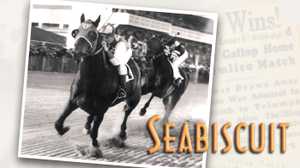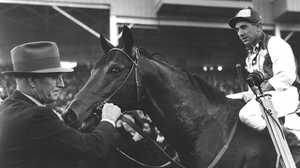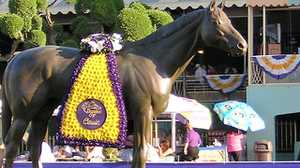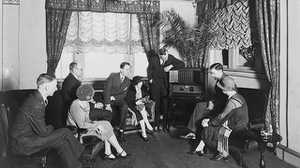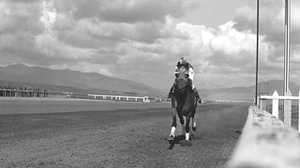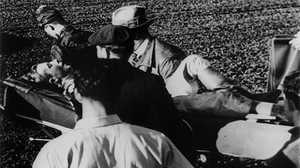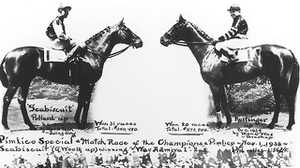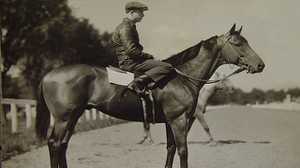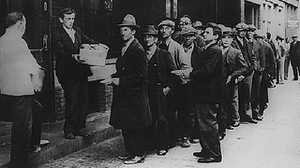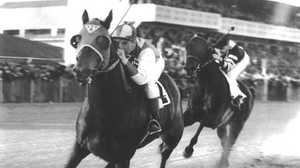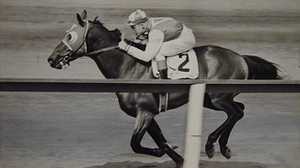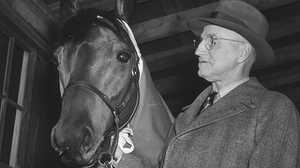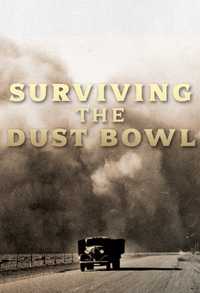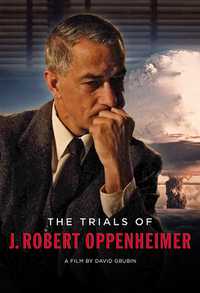Narrator: On New Year’s Eve 1938, columnist Walter Winchell published his annual list of the top ten newsmakers. Nine men were named, including Franklin Delano Roosevelt, Neville Chamberlain and Adolf Hitler. The tenth spot went to a horse.
Gelo Hall, Jockey Agent: He was a hero. This horse had to come from the bottom of the heap. To the top.
Newsreel (archival): They’re head and head. It’s horse against horse. Seabiscuit leads by a length…
Gelo Hall, Jockey Agent: And he fought his way up the ladder. And I think this was the thing that people liked about him. And I think that’s the way America likes sometimes to crown their champions.
Newsreel (archival): Ladies and Gentleman, NBC has turned over its nationwide facilities for a paid tribute to Seabiscuit, the Wonderhorse.
Gene Smith, Writer: Maybe the fact that he had the hard scrabble beginning…maybe the fact that he wasn’t good-looking—he was blocky, he was coarse, crude-looking. Maybe the fact that he had a kind of busted down jockey…somehow it all came together to create a star.
Laura Hillenbrand, Author: He came along in the worst years of the Depression. Americans were down and out. They were poor, they were losing their jobs and their houses and they, they wanted a hero that came from the wrong side of the tracks, that was beat up like they were. And for a brief moment in America, a little brown racehorse wasn’t just a little brown racehorse. He was the proxy for a nation.
Film Clip from The Story of Seabiscuit, Trainer (archival): Sure he’s small in the body, but big in the heart.
Film Clip from The Story of Seabiscuit, Shirley Temple (archival): What do they call him?
Film Clip from The Story of Seabiscuit, Trainer (archival): Seabiscuit.
Newsreel (archival): Out of the musical Hall of Fame, “The Big Ten,” a tune that has captured the fancy of the nation…
Narrator: On a mild summer afternoon in 1936, a three-year-old thoroughbred named Seabiscuit was saddled up for a cheap stakes race at Boston’s Suffolk Downs. The purse was a paltry $700.
The colt was a direct descendant of the legendary Man o’ War—but you’d never have known it to look at him. Dung-colored, stocky, and low-slung, with knobby, asymmetrical knees that didn’t quite straighten all the way, he was a masterpiece of faulty construction.
He’d been raced an astonishing thirty-five times as a two-year-old, more than triple the average for a horse his age — and he’d lost nearly every time.
But now, as he ambled past the grandstand, he caught the eye of one of the spectators, a veteran horse trainer named Tom Smith.
Laura Hillenbrand, Author: Smith nodded at the horse and the horse nodded back at him, and (Smith) later said it was kind of as if the horse was paying an honor to notice him, and the pony boy tugged the horse on his way, and Smith said, “I’ll see you again.”
Narrator: Despite his appalling record, Smith saw something special in the colt. “He had a look,” the trainer said later, “of true confidence.”
Smith’s employer, an ex-bicycle repairman turned automotive magnate named Charles Howard, saw it too. A few weeks later, he bought Seabiscuit for the bargain-basement price of $8,000, and sent him west with Smith, to the Detroit Fairgrounds racetrack to train.
The stablehands in the Howard barn were skeptical. None of them had ever seen such an equine catastrophe. The colt paced in his stall, broke into a lather at the sight of a saddle, and lunged at anyone who dared to go near him. When he ran, his left foreleg jabbed out wildly, as if he were swatting flies. Horsemen called it “an eggbeater gait” — and most considered it a sign of lameness.
But Tom Smith knew what he was doing. A man so laconic that a reporter once suspected he’d removed his tongue, Smith had little patience for people or their opinions. [But] horses he understood.
Farrell Jones, Former Jockey: I think all he ever thought about was a horse. Silent Tom is what they called him. Phuh — he’d do that — phuh, phuh. But I don’t know that he was aware he’d do it; I don’t think that… no, he’d do that. I’d see him — phuh, phuh — do that quite a bit. He was a great horse trainer. He was a dedicated guy to what he did and that was it.
Narrator: Smith made a careful study of Seabiscuit, then devised a regimen targeted to the colt’s specific problems. For nerves, an assortment of soothing animal companions — a spotted dog with enormous platter-like ears, and an amiable yellow cow-pony named Pumpkin. For leg soreness: daily applications of a homemade liniment. And finally, a diet consisting of a high-quality, calcium-rich strain of timothy hay which had to be special-ordered from Northern California.
The stablehands were instructed to give Seabiscuit maximum latitude — and, most importantly, to never, ever disturb him while he was sleeping.
Laura Hillenbrand, Author: Most horses can only sleep on the ground for about five minutes at a time because their bodies are so enormous, and they’re configured in such a way that breathing becomes difficult. Seabiscuit was the exception. He would sleep and sleep and sleep.
Narrator: Gradually, Seabiscuit relaxed and rounded into form — but he still didn’t show much interest in running. Smith wondered where he would ever find a jockey sensitive enough to handle him.
As it happened, the jockey found him. His name was John Pollard — but thanks to a shock of flame-colored hair, most people called him “Red.”
Norah Christianson, Red Pollard’s Daughter: He was very, very charming. He had a face, kind of a leprechaun-ish face and he was not short. He was about 5’6”. And that is tall for a jockey… very thin, sinewy. Like a dancer. He quoted Shakespeare at great length and he carried around several books of poems everywhere he went. I think he was capable of being a great many things. My father went to the fourth grade and a teacher told him that he wouldn’t amount to anything. And I think that, uh, that rode him all his life.
Narrator: One of seven children born to a bankrupt brick manufacturer, Pollard had left home at fifteen in the care of a guardian — who then promptly abandoned him at a makeshift racecourse in Butte, Montana. He’d spent the next dozen years kicking around the country’s lowliest tracks, talking his way onto as many mounts as he could and working as a prizefighter to make ends meet.
Pollard drifted onto the Detroit Fairgrounds one afternoon in July 1936, with twenty-seven cents and a few sugar cubes in one pocket, and in the other, a half-pint of a cheap brandy he called “bow-wow wine.”
Laura Hillenbrand, Author: Red Pollard had been at a racetrack where his last mount had simply refused to finish his race. He had a six percent winning average, which is horrendous for a jockey. He would have taken any mount that day, and he went to every single barn on the track. No one would hire him, and he went into the last barn, and Tom Smith gestures to the stall, says, “I’ve got a horse here.”
Norah Christianson, Red Pollard’s Daughter: When they first met, he talked to the horse and the horse responded positively, which this horse did not usually do, and Tom Smith being a very astute judge of man and beast, he knew there was something there… some affinity. A connection.
Laura Hillenbrand, Author: Pollard put his hand in his pocket, pulled out a sugar cube and held it out to the horse. And the black muzzle touched the jockey’s shoulder. It was the first affectionate thing Seabiscuit had done to anybody and Tom Smith thought “this is my man.”
Red Pollard had spent his career at bad racetracks on bad horses. The worst animals on the circuit. He understood troubled horses. He was not a guy you would put on a great racehorse, but this is the one he fit. So, he wasn’t a great jockey, but the moments he was on Seabiscuit, he was great.
Narrator: Separately, they were nothing more than a failing jockey and a broken-down horse. Together, they would become hard luck heroes for a troubled nation.
In the lean days of the Depression, Thoroughbred racing was fast becoming America’s most popular sport. Bans on wagering, passed at the turn of the century, had mostly been lifted by the late 1920s — and revenue-hungry states across the country had rushed to re-legalize racing.
Newsreel (archival): Bookie shouting numbers.
Gene Smith, Writer: The opportunities for gambling in the 1930s were very limited. There were no state lotteries. Football was a very minor sport. You wanted to bet on a prize fight, you had to go find a bookie or something. There were casinos in Nevada, but how many people go to Nevada, hence the only place you could really bet was at a racetrack.
Jack Whitaker, Sportscaster: I expect it was a release the dream of making a lot of money, which was in everybody’s head in those days. And I would think that it was an escape for them like the movies were, radio was escape, because it was kind of a brutal time people went to the races six days a week in those days — twenty thousand, forty thousand people.
Narrator: By the fall of 1936, Tom Smith still didn’t know if his gamble on Seabiscuit would ever pay off. One afternoon, he put an exercise rider on the colt’s back, pulled out his stopwatch, and shouted to turn Seabiscuit loose.
The horse came rolling down the backstretch, his body flattening out with each stride, his speed building. By the time he blew by Smith, he was covering more than fifty feet a second — and still picking up steam.
Laura Hillenbrand, Author: He kept thinking the horse couldn’t possibly be going this fast, and the horse went under the wire, and he clicked the stopwatch, and the horse had crushed the track record, and this was in a workout. Horses rarely run as fast in workouts as they do in real races, and Smith knew what he had on his hands and he had an opportunity here to conquer the racing world and to make history, and he knew he had to do everything right with this one.
Narrator: The first event on Seabiscuit’s schedule was the annual Governor’s Handicap in Detroit — a small-time event with a big local following.
Among the 28,000 spectators in the stands that afternoon were Charles Howard and his wife Marcela, who’d driven out from California to see what their new horse and his jockey could do.
At 5:39 pm, the starter bell rang. One minute and fifty seconds later, with the crowd on its feet, Seabiscuit crossed the wire first by a nose. In the time it takes to fry an egg, he’d recouped over half of his purchase price. “This Seabiscuit… runs like he means it,” sportswriter Jolly Roger exclaimed, “… with fire, slash and zam.”
Over the next twelve weeks, as Seabiscuit thundered to the winner’s circle again and again—some insiders were touting him as “a dangerous contender” for the Santa Anita Handicap, the signature event at California’s brand new racetrack.
Newsreel (archival): The $100,000 Santa Anita Handicap brings out California’s biggest racing crowd. Movie stars on every hand for the world’s richest race.
Laura Hillenbrand, Author: It was probably the richest sporting event in the world. One hundred thousand dollars — all to the winner. A massive amount of money. This is the time when the average American is earning less than $500 a year.
Narrator: On the afternoon of February 27th, 1937, a record crowd of sixty thousand spectators turned out for the third annual Santa Anita Handicap — better known as “the hundred-grander.”
Despite his recent victories, most professional odds makers still considered Seabiscuit a long shot. The smart money was on Rosemont — the lightning-fast five-year-old that had recently trounced 1935’s Triple Crown winner. Nearly $400,000 was riding on the contest — an all-time betting high for western racing.
Newsreel (archival): There they go…
Narrator: The entire field broke at once, in a mad dash for position.
Newsreel (archival): Here on the outside comes Rosemont in a good position…
Narrator: For the next half-mile, Pollard patiently threaded Seabiscuit through the pack, before finally tucking in behind the front-runner.
Newsreel (archival): One half a mile…
Narrator: Rosemont, meanwhile, was on the move from behind, darting in and out of the field, inching up on the outside.
Newsreel (archival): Seabiscuit is now moving up…
Narrator: At the top of the home stretch, Seabiscuit swung into the lead with Rosemont hard on his heels.
Newsreel (archival): Seabiscuit has got the lead and the battle’s on and it’s anybody’s race right til the end.
Laura Hillenbrand, Author: It looked like he had it. They were running down midstretch with a clear lead, and Red Pollard kind of froze. This was the biggest moment in his career, and he stopped urging the horse. For fifteen strides, he just sat there and he started slowing down.
Narrator: With only fifty yards to go, Pollard suddenly snapped into action and dropped the whip across Seabiscuit’s flank.
The two horses hurtled under the wire together.
Newsreel (archival): A photo finish, all eyes turn upward to the photo booth. An eternity for those who anxiously await the outcome — down the slender wire to the judges platform, closely determine the microscopic difference…
Narrator: The winner was Rosemont, by a nose.
Laura Hillenbrand, Author: Red Pollard got off the horse, and could see that everyone was looking at him with accusation. Why had he stopped riding the horse for 15 strides? He had blown the race. From everyone’s perspective it was inexplicable what he had done.
I think the reason why Red stopped riding was that he couldn’t see Rosemont coming. Rosemont was to his outside, and Red was blind in his right eye.
At the beginning of his career, he was struck in the back of the head with something kicked up by another horse’s hooves. It hit his head right over the visual center of his brain and blinded him in one eye.
So he couldn’t tell how close he was cutting it. He, he rode right into the pack with one eye. And he kept it secret. His closest friends didn’t know it. If he had admitted he was blind in one eye, the stewards would rightly have banned him from the track, and he never would have ridden again. It was the only life he knew. It was the only thing he wanted to do, so he had to just let people criticize him and say nothing.
Narrator: The furor over Pollard’s mistake made Seabiscuit a local celebrity. Had it not been for his jockey, West Coast sportswriters insisted, the horse would have surely run off with a hundred grand.
But the adulation was far from universal. In the prestigious racing circles of the East, most racetrackers still regarded Seabiscuit with skepticism—if not outright scorn.
Jack Whitaker, Sportscaster: Always the Eastern people would sneer, “Oh — he’s aCalifornia horse,” and for many years they were right! [laughs] Because it was the Eastern horses cleaning up on the Triple Crown races anyway.
Narrator: If Eastern horsemen wanted proof of Seabiscuit’s mettle, Charles Howard meant to give it to them. On March 13th, 1937, he packed his horse off on an exhaustive cross-country racing campaign. “Seabiscuit will take on all comers,” he told the press, “and he’ll mow them down like grass.”
Newsreel (archival): Seabiscuit took them all on. Back and forth he shuttles…from train to track.
Narrator: That summer and fall, the Eastern racing establishment dined almost exclusively on crow.
Shipping an unheard-of 8,000 miles, Seabiscuit blazed to victory in ten major stakes races, boosting his total earnings for the year to 144,000 dollars — more than the world’s top money-winner had earned in his best season ever.
Newsreel (archival): Sports-loving fans have found an idol and backed Seabiscuit to the limit…
Narrator: But he did not win the coveted title of Horse of the Year. That honor went to an eastern-bred three-year-old, the son of Man o’ War and only the fourth horse in history to win the Triple Crown. His name was War Admiral.
Imperious and temperamental like his legendary sire, War Admiral was infamous for throwing wild tantrums in the starting gate. But in a race, he was breathtaking.
Newsreel (archival): There’s not a colt today can catch the Admiral’s flying heels. And it’s War Admiral by four lengths!
Narrator: War Admiral didn’t run — he flew. On the oval, no other horse ever got close to him. But some racing fans believed Seabiscuit just might.
Newsreel (archival): All turfdom wants to know if Seabiscuit can beat the great War Admiral….
Narrator: If Seabiscuit were going to claim the turf championship, he’d have to dethrone War Admiral. One of the century’s greatest sports rivalries had begun.
The match-race fit right in with Howard’s plan to make Seabiscuit a star. But War Admiral’s notoriously cantankerous owner, Samuel Riddle, refused to commit. He had no intention of demeaning his horse’s reputation, he told reporters, in a contest against a Western colt.
So the Howard barn returned to California to prepare for the next best thing: another go at the Santa Anita Handicap. This time, they vowed, Seabiscuit would win.
But as the race drew near, their confidence began to wane. Days of drenching rains turned the track to a swamp, and Seabiscuit — never at his best in the mud — was scratched from one warm-up after another.
Finally, a restless Pollard opted to ride a race without him, climbing aboard Howard’s star filly, Fair Knightess, instead. It was a decision he would come to regret.
Halfway around the turn, Fair Knightess clipped the heels of the horse in front of her and tumbled, pitching Pollard over her head and crushing him beneath her as she thudded to the ground.
Farrell Jones, Former Jockey: That mare just fell and fell on him and fell like, lucky he didn’t kill him. I mean you take a horse that weighs a thousand pounds and, and it lays on you a little bit and… you ain’t gonna last.
Narrator: Pollard’s diagnosis was grim: a shattered collarbone, a broken shoulder, multiple rib fractures and serious internal injuries. The doctors said he wouldn’t ride again for at least a year. The hundred-grander — and his chance to redeem the loss to Rosemont — was gone.
Laura Hillenbrand, Author: During his time in the hospital, it tortured him to not be out there with the horse. This was a very unfortunate man; he was a very tormented man. And was more star-crossed than any athlete I know of.
Norah Christianson, Red Pollard’s Daughter: I do think there is a real lure to living your life all the way up, which is what Hemingway said, only bullfighters live their lives all the way up and he meant by that that every day, every day they face death, and it does put an edge to things, you know, and I think he had to have that. That defined him, that was what he was.
Narrator: Three days later, his left arm in traction, Pollard made it clear that there was only one jockey who could replace him — his old friend, George Monroe Woolf.
Leonard Dorfman, Trainer: They called George “the Iceman” because he could sit chilly on a horse as long as anybody. I thought he was perfection in motion, really. To watch George Woolf ride, really to watch him coming down the stretch on a horse, boy he, he looked beautiful to me. Uh, I don’t know whether he was helping the horse, but he sure looked like it.
Gene Smith, Writer: A great jockey is a genius. What a jockey needs to do is have supreme balance. He has to have the fingers of a great pianist in order to sense through the reins what the horse is capable of. The jockey through his knees senses what the horse is doing. The only part of the jockey that never touches anything is the part that should normally go into the saddle. When to whip. When to hold back. To go inside. To go outside. To go through an opening this big where your elbows brush the jock next to you at forty-something miles an hour, and your stirrups clang against his stirrup, all of this a 110-pound man on top on a 1,200-pound horse. It’s a thing of beauty.
Helen Luther, Red Pollard’s Friend: To be behind a horse and have all the dirt and mud and everything else in your face going through on the inside, of course, that’s dangerous — it took nerve. Or else, no sense. I used to say, “No brains, no fear.” They had a joke about, riders who, you know, were a little skittish and if they’d ever be on the outside, they’d say, “Oh yes, he took the married man’s route.”
Narrator: Off the track, a jockey’s existence was marked by the constant, grueling struggle to make weight. The limit hinged on the ranking of the mount — the better the horse, the higher the weight he was assigned to carry, the heavier the jockey could be.
But even the best horses seldom carried a rider who tipped the scales at more than 114 pounds. If a jockey wanted to ride with any kind of regularity, he had to whittle down to at least 110.
Gene Smith, Writer: Weight can stop a freight train is an old racetrack expression. Two or three pounds is over the assigned weight. It means that the horse, before he comes out of the gate, he’s lost several lengths because he’s got to tote that extra weight. Jockeys can’t expect to make a living if they’re gonna eat well. As a matter of fact, some time ago, I was talking to a very famous jockey and I said, “What are you going to do when you retire,” and he said, “Eat lunch.”
Newsreel (archival): The thermometer reads a hundred and forty, but Billy Passmore lies under a blanket — too much breakfast. And Bobby Stevenson is compensating for a couple of hamburgers he just couldn’t resist.
Narrator: George Woolf weighed in at 115 pounds — five less than the recently-crowned Miss America, but hefty by turf standards. While lighter jockeys rode more than a thousand races a year, Woolf averaged fewer than 200. But his winning-average was so high that he still ranked among the best money-riders in the country. Not surprisingly, Woolf was confident about the hundred-grander. He even made Pollard a promise: when Seabiscuit won, they’d split the jockey’s $10,000 share right down the middle.
Newsreel (archival): Sportfolio 1938 and the $100,000 Santa Anita handicap is off and running with 18 top thoroughbreds streaking past the grand stands. The famous Seabiscuit jams his way through the bunch as he starts his drive toward the leaders. But Stagehand plods along steadily on the outside getting positioned for one of the greatest stretch duels in handicap history. Seabiscuit and Stagehand hook the pace together and it boils down to a thrilling two-horse race. Seabiscuit on the inside, Stagehand on the outside, neck and neck to the wire but in the last jump it’s Stagehand in a fantastic photo finish.
Narrator: Even though he’d lost the hundred-grander for the second time in a row, Seabiscuit had turned in one of the most dazzling performances in the history of thoroughbred racing. Fouled early by a hopeless long shot, he’d catapulted from twelfth place to first in just half a mile, only to wind up in fierce homestretch drive against a horse toting thirty fewer pounds. And still, he’d only lost by a nose.
Leonard Dorfman, Trainer: The best race I’ve ever seen a horse run was the day that Stagehand beat him in the Santa Anita Handicap.
Newsreel (archival): Seabiscuit is back about ninth, now Georgie Woolf has got him clear and trying to fight his way through there…
Leonard Dorfman, Trainer: This horse, with 130 pounds on his back, spotting the other horse 30 pounds and making that big move to pass all those horses and go to the front and then have Stagehand come running at him like he was gonna run right by him and then Seabiscuit just took off.
Newsreel (archival): And now there goes Seabiscuit going to the front, but look out for Stagehand…
Farrell Jones, Former Jockey: It was unbelievable to me this day, what happened. He kept running; he kept running even after he got away from the trouble. He did that. He was phenomenal.
Newsreel (archival): The Mighty Biscuit loses…
Newsreel Announcer 1 (archival): What about Seabiscuit?
Newsreel Announcer 2 (archival): Shut off I think when the gate went up.
Newsreel Announcer 1 (archival): Gave him a bad start…?
Newsreel Announcer 2 (archival): Yes.
Newsreel Announcer 1 (archival): Ran a great race after that…
Narrator: “Now that all the hullabaloo on the handicap has died down,” one turf scribe wrote, “the time has come to assert that Seabiscuit was the best horse in the race.”
It was an opinion that would be voiced over and over again, in newspapers from Syracuse to Sacramento. Never before had a race horse been so widely praised for losing.
Gene Smith, Writer: You have a downtrodden, Charlie Chaplin-esque figure who comes out of the mire and the sorry exploitation of the little man. Probably there are people who thought to themselves I’m making twenty dollars a week, it’s enough to support my family, but I could lose my job tomorrow, but maybe someday I’ll come back and be the great guy I always was destined to be, look at Seabiscuit. He did it.
Narrator: All across the country, people who’d never even been to a racetrack caught the fever. One sportswriter called it “Seabiscuit-itus.”
Laura Hillenbrand, Author: He drew enormous crowds. People would crowd by the railroad tracks when he went across the country. In little remote towns, people would crowd up next to the train to see if they could get a little glimpse of him.
Newsreel (archival): Can you get a little closer…
Laura Hillenbrand, Author: He was merchandised to a phenomenal degree. There were Seabiscuit ladies’ hats sold on Fifth Avenue. There were at least five Seabiscuit board games. There was a Seabiscuit pinball machine. He had his own line of oranges. He endorsed dry-cleaning services and hotels, absolutely everything. He was a superstar. He would have been a superstar in any era, but he came along at a time when America was desperate for inspiring heroes. Heroes that looked like America.
Newsreel (archival): It’s a new track record for the mile and an eighth as Seabiscuit shoves his whiskers for the home plate just enough to hit the handsome jackpot.
Good afternoon ladies and gentlemen, this is Ken Carpenter greeting you from Santa Anita racecourse in Arcadia California….
Seabiscuit gets a big hand. I can see them applauding…. Seabiscuit carries his top weight of 133 lbs. to a spectacular victory in record-shattering time….
Laura Hillenbrand, Author: At the beginning of his career, about half the people in America had radios. By the end of it, virtually everybody did, and there were eight million sets in cars.
Newsreel (archival): Seabiscuit is standing very quietly…
Laura Hillenbrand, Author: Seabiscuit raced during the racing season about once a week, so it became an American ritual to gather around the radio and listen to him run and it has a lot to do with why he became such a huge celebrity in America. He was one of the first big radio stars.
Newsreel (archival): This is the National Broadcasting Company…
Narrator: In the Spring of 1938, Seabiscuit made headlines almost every day, as breathless sportswriters broke the news that the Howard bay would at last meet his arch-rival, War Admiral, in a full-field race at Boston’s Suffolk Downs.
All over the country, magazines and newspapers featured side-by-side photographs of the celebrity horses, offering endless comparisons of their relative size and speed and merits. Sportswriters furiously polled fans for their predictions, and composed lengthy editorials on the likely outcome of the race.
“I am one of the narrow-minded group which has seen War Admiral run too often,” one columnist wrote, “to concede Seabiscuit a chance for anything better than a seat in Congress this year.”
Gene Smith, Writer: People looking at War Admiral saw a magnificent horse. Good-looking. Came from an illustrious background. He came from an aristocratic barn. Seabiscuit doesn’t have that long, elegant, aristocratic, wide-eyed look of eagles. He looked like he ought to be drawing a cart with ice behind it some place.
Narrator: Seabiscuit’s fans hailed him as a plain working man, a proletarian, a modern Horatio Alger. “He’ll take that fancy little War Admiral,” one predicted, “and curl him into a pretzel.”
Six days before the race, a fully-recovered Pollard did an old friend a favor and agreed to work his green two-year-old colt. Halfway around the oval, the horse spooked, crashed through the rail, and tore off in the direction of the barns. As he tried to cut between two sheds, he skidded sideways, smashed into a corner, then crumpled in a heap.
At the far end of the shed row, they heard the screams. Pollard’s right leg had been nearly severed just below the knee.
Norah Christianson, Red Pollard’s Daughter: The pain was excruciating, excruciating. He had such a lot of bad luck with regards to spills. And my father would get so enraged if you ever said, if anyone ever said, you know that he fell off a horse. He would say, I don’t fall off horses. I was thrown!
Helen Luther, Red Pollard’s Friend: I don’t know how he held himself together. Especially when they tore his leg open — when the bones were fractured. Oh, I don’t know how he stood it.
Narrator: All through that summer, Pollard lay in bed in a Boston hospital, reading Emerson while surgeons fretted over his leg. They twice rebroke and reset it, but the splintered bones would not heal. His body shriveled to a scant eighty-six pounds. The doctors told Pollard he would never ride again.
Norah Christianson, Red Pollard’s Daughter: I think he was immensely, deeply disappointed, like one of the great disappointments in his life, but I think he had a perspective on all that, through philosophies of the writers that he read. He would always say — this comes from Shakespeare, — “sweet are the uses of adversity.”
Narrator: As summer turned to fall, adversity’s uses took shape in the person of Agnes Conlon, Pollard’s private duty nurse. The daughter of a well-to-do Boston antique dealer, she was educated, refined, reserved — Red’s opposite in almost every way. She was also already spoken for.
Pollard was smitten enough not to care. One afternoon, he looked up from his poetry and asked Nurse Conlon to marry him. To the horror of her status-conscious family, Agnes said yes.
Norah Christianson, Red Pollard’s Daughter: Her parents looked askance at her going to marry my father, as if he were out of the circus or something strange like that. And ah, a long time later, I learned from an aunt, she said, “You know, none of us wanted her to marry him. We just didn’t think that he was worthy of her.”
Newsreel (archival): Millions of racing fans in America and abroad look anxiously toward the richest match race in the history of the sport of kings…
Narrator: By the fall of 1938, the Seabiscuit-War Admiral match-up had been rescheduled. They would meet, one-on-one, November 1st at Maryland’s Pimlico Racecourse. “The whole country is divided in two camps,” the San Francisco Chronicle observed. “People who never saw a horserace in their lives are taking sides.”
Newsreel (archival): The crowd makes War Admiral an odds-on favorite.
Narrator: George Woolf had signed on to ride Seabiscuit — and for the first time in his career, he wasn’t sure he would win. The night before the race, he’d even called Pollard for advice.
His instructions had been simple, if highly unorthodox. Gun Seabiscuit at the start, he told Woolf, and then let War Admiral catch up. “Once a horse gives Seabiscuit the old look-in-the-eye,” Pollard said, “he begins to run to parts unknown…”
Thirty thousand people filled the grandstand that afternoon. Another ten thousand jammed into the infield. Outside the track, ten thousand more gathered ten-deep around the fence, and scrambled up tree limbs and telephone poles as far as a mile from the start.
Gelo Hall, Jockey Agent: I was in the Grandstand. And if I can recollect, distinctly, I was squeezed in, because that’s how many people were there. I was squeezed in just around the 3/16 pole, where the horses broke. It was so enthralling. It was a two-horse extravaganza. I mean, they had built the race to an outstanding pitch. Everybody knew what was coming… that… particular… day. Everybody knew. East Coast. West Coast. I mean it was in the air. It engulfed you, I mean, it was just like, man it’s about to happen. Waiting for the bell to ring.
Narrator: Down at the paddock gate, the announcer Clem McCarthy began to make his way to the radio booth, but the crowd was so thick he couldn’t get through.
Newsreel (archival): Ladies and Gentlemen I found it impossible to get through this enormous throng at Pimlico today — the first time I’ve ever failed to do that from the paddock…
Narrator: So he climbed up on the track’s outer rail, down by the wire, and settled in to call the race from there. Across the country, forty million listeners — one out of every three Americans — tuned in to the broadcast.
Clem McCarthy (Archival): And they’re off! It’s a go, Georgie Woolf is at the whip on Seabiscuit to key him up and they’re coming to me head and head. War Admiral on the inside. Woolf is fighting Seabiscuit and Seabiscuit is outrunning him. Seabiscuit is coming to me one length – two lengths in the lead. And he came right over two lengths, he goes by me. Seabiscuit by two lengths, War Admiral right on his heels. War Admiral is trailing him around the turn. Seabiscuit on the lead by two lengths . War Admiral is second to him and Kurtsinger is sitting still. Now War Admiral is trying to move to him. They’re going into the backstretch. Seabiscuit by a length and a half. Now Seabiscuit by two lengths , War Admiral second. Seabiscuit by two lengths – they’re going up 3/4 of a mile to come. And it’s Seabiscuit by a length and a half, down the backstretch. They’re halfway down that backstretch and there goes War Admiral after him.
Now the horse race is on! And I’m losing them… they’re head and head, but I’ll catch them in about 50 yards. They’re head and head and now War Admiral has a head advantage and Seabiscuit’s got a head advantage. They’re going into that far turn, head and head, and it is either one – take your choice… as they head for that home lane.
This is a real horse race, just what we had hoped we’d get. They’re head and head and both jockeys driving. It’s the best horse from here in. They’ve 200 yards to come. It’s horse against horse. Both of them driving. Seabiscuit leads by a length. Now Seabiscuit by a length and a half. Woolf has put away his whip. Seabiscuit by three; Seabiscuit by three.
Seabiscuit is the winner! By four lengths! And you never saw such a wild crowd. Seabiscuit’s the winner! By four lengths. Trying to drown this crowd out here. They’re roaring around me. Seabiscuit was the winner from end to end. By four lengths.
Narrator: Seabiscuit’s final time blazed across the tote board. No horse in Pimlico’s history had ever run the distance so fast. “Speed of that kind,” one turf scribe said, “is what is known as kissing the boys good-bye.”
Newsreel (archival): It’s a hero’s reception. Seabiscuit, undisputed king of thoroughbreds. He rewards his backers with six dollars and forty cents for each two dollars, and that’s certainly worth a blanket of flowers….
Narrator: “Seabiscuit did just what I thought he’d do,” Pollard told a columnist the next day, “He made a rear admiral out of War Admiral.”
When it came time, a few weeks later, for reporters to cast their ballots for Horse of the Year, there was no debate over which one deserved the honor. “The Biscuit,” sportswriter Bill Corum wrote, “turn[s] out to be the kind that Momma used to make.”
Just six weeks later, Seabiscuit’s career seemed over.
On February 14th, 1939, as he swung around the final turn of a prep race at Santa Anita, Seabiscuit stumbled. His left foreleg suddenly giving way. His suspensory ligament had been ruptured.
It was likely that he would never run again.
Howard was crushed. But he refused to use the word “retirement.” He took his horse home to his California ranch for what he called “a nice, long rest.”
In April, Pollard arrived with Agnes. He was flat broke, and had no home to offer his new wife. Graciously, the Howards took them in. For a third time, his leg had been broken and reset. He hobbled along now, and drank to dull the pain. “[Seabiscuit and I] were a couple of old cripples together,” Pollard later said, “all washed up.”
Throughout the summer of 1939, horse and jockey convalesced together — taking long, limping walks, pushing a little farther each day. By September, they were up to five miles. “Out there among the hooting owls,” Pollard later remembered, “we both got sound again.”
Norah Christianson, Red Pollard’s Daughter: I think that my father found a solace in watching this horse come back and grow strong, and I think in some ways, well Seabiscuit became his role model in a way. If he can do it, I can kind of thing.
Narrator: Late that fall, Charles Howard made an extraordinary announcement. On March 2nd, 1940, seven-year-old Seabiscuit would take one last stab at the race that had so far eluded him, Santa Anita’s hundred-grander.
But there was no mention of who would be in the saddle. “If Red breaks that leg again,” Howard said, “he’ll be crippled for life.”
Still, Pollard insisted he was fit enough to ride. “Old Pops and I have four good legs between us,” he told a close friend. “Maybe that’s enough.”
Norah Christianson, Red Pollard’s Daughter: He didn’t go to Howard and say “Please let me ride Seabiscuit in this handicap.” But Howard had doubts about the condition of his leg and a friend of my father’s said, “Maybe it’s better to have a man break his leg, than to break a man’s heart.”
Narrator: Finally, Howard made his decision. Pollard would ride Seabiscuit in the Santa Anita Handicap.
On race day, Red came into the paddock just before four o’clock. Around his neck hung a medal of St. Christopher that Agnes had given him for luck. He wasn’t too proud to admit he needed it.
Newsreel (archival): Eyes of the turf world are on Santa Anita and the comeback of the great Seabiscuit. Twice, he’s lost the $100,000 handicap by a nose. Now, if those valuable pins can stand the gaff today, he’ll try again.
Narrator: As Smith hoisted him into the saddle, Pollard felt his confidence return. “You know the horse and the horse knows you,” Smith whispered. “Bring him home.”
For Pollard, it would all come down to that. Exactly one minute and thirty-six seconds after the bell rang, he found himself bottled up at the top of the homestretch, with Seabiscuit straining at the reigns. There was no way around the front-runners.
Finally, at the far turn, a lane opened barely wide enough for the horse to get through. Pollard leaned forward in the saddle and shouted, “Now, Pop!”
At the touch of the whip, Seabiscuit broke through and exploded into the lead. He and Pollard scorched down the stretch and under the wire all alone.
Seabiscuit had clocked the fastest mile-and-a-quarter in Santa Anita’s history, the second-fastest ever run on an American track, and had surpassed the world money-winning record by more than 60,000 dollars. Some called it the greatest comeback in the history of American sports. “Oh,” wrote columnist Jolly Roger, “that I have lived to see this day.”
In the winner’s circle, Pollard sat straight-backed on his horse, his red hair matted with sweat. Beneath him, Seabiscuit was still, calmly munching the flowers from his victory wreath as dozens of camera bulbs flashed. “Don’t think,” Pollard said later, “he didn’t know he was the hero.”
Gene Smith, Writer: He suffered career-ending injuries and surmounted them, he ran until a very advanced age, and he was ridden by a jockey who suffered calamitous accidents, who somehow pulled himself together…two crippled old men who go out in a blaze of glory and do great things and to a depression-ridden, anxious, frightened nation, it must have come like a great sunrise.
Norah Christianson, Red Pollard’s Daughter: I think that my father understood that it was just by chance that he became famous. So many millions have talent or beauty, and they haven’t been in the right place at the right time, they haven’t drifted into an arena where they could be appreciated. I think he knew that very deeply. That it was all luck. I think that together Seabiscuit and he made a whole, a comet, a star, a ball of light.
Laura Hillenbrand, Author: There is something quintessentially American about everyone in this story. About the ability to triumph over hardship—that’s the journey, that’s the journey toward the American dream. This country was built on that. And he embodies that more than anybody else. He is an extraordinary story that way.
